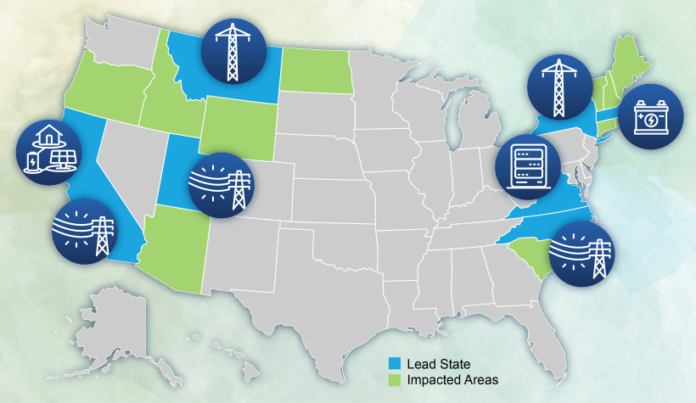The U.S. Department of Energy (DOE) has announced a $1.5 billion investment in four transmission projects that are expected to improve grid reliability and resilience and relieve transmission congestion.
Supported by the Bipartisan Infrastructure Law and administered through DOE’s Grid Deployment Office (GDO), the projects selected for the Transmission Facilitation Program will enable 1,000 miles of new transmission development and 7.1 GW of new capacity throughout Louisiana, Maine, Mississippi, New Mexico, Oklahoma and Texas.
DOE also released the final National Transmission Planning (NTP) Study, a set of planning tools and analyses that examine a range of potential future scenarios through 2050 to identify pathways to maintain grid reliability, increase resilience and reduce costs, while meeting local, regional, interregional and national interests and supporting the changing energy landscape.
The study finds that the United States will need to double to triple the 2020 transmission capacity by 2050 in order to meet demand growth and reliability needs, and cost savings can be achieved through transmission expansion and interregional planning.
“The U.S. transmission network is the backbone of our nation’s electricity system. Though our grid has served U.S. energy needs for more than a century, our country’s needs are changing,” says David Turk, U.S. deputy secretary of Energy.
“DOE’s approach to deploying near-term solutions and developing long-term planning tools will ensure our electric grid is more interconnected and resilient than ever before, while also supporting greater electricity demand. The Biden-Harris Administration is committed to bolstering our power grid to improve the everyday life of Americans through affordable power, fewer blackouts, more reliable power and additional jobs across our country.”
To catalyze near-term transmission deployment, DOE announced an investment of $1.5 billion in four transmission projects through the Transmission Facilitation Program. The projects are set to improve critical interregional grid connections, bring diverse clean energy resources to more customers and bolster resilience to extreme weather.
These projects announced will enter capacity contract negotiations with DOE:
- Aroostook Renewable Project will construct a new substation in Haynesville, Maine and a 111-mile transmission line with a capacity of 1,200 MW to connect the new substation to the Independent System Operator-New England system at a substation in Pittsfield, Maine. The project will provide New England with access to clean energy generated in northern Maine, while creating 4,200 construction jobs and 30 permanent operations jobs. It has a $425 million potential contract value.
- Cimarron Link is a 400-mile high-voltage direct-current (HVDC) transmission line from Texas County, Okla. to Tulsa, Okla. The line will transmit 1,900 MW of point-to-point capacity to deliver wind and solar energy to load centers in eastern Oklahoma and elsewhere in the Southwest Power Pool, while creating more than 3,600 construction jobs and 20 permanent operations jobs. It has a $306 million potential contract value.
- Southern Spirit will construct a new 320-mile HVDC line connecting the Electric Reliability Council of Texas grid for the first time with electric grids in the southeastern U.S. power markets, including Midcontinent Independent System Operator South and Southern Company. This line across Texas, Louisiana and Mississippi will provide 3,000 MW of bidirectional capacity and create 850 construction jobs and 305 permanent operations jobs. It has a $360 million potential contract value.
- Southline will construct an 108-mile transmission line to deliver 1,000 MW of bidirectional capacity between Hidalgo County, N.M. and Las Cruces, N.M., creating 150 new construction jobs and helping meet energy needs of industries investing in the region, including semiconductor, battery manufacturing, and data center facilities. It has an $352 million potential contract value. The new selection is for Phase 2 of the Southline Project, following the prior selection of Southline Phase 1, a 175-mile line from Hidalgo County, N.M. to Pima County, Ariz.in the first round of the Transmission Facilitation Program.




